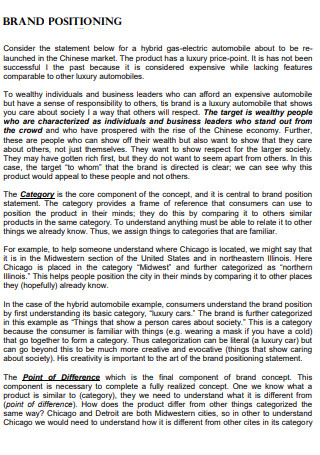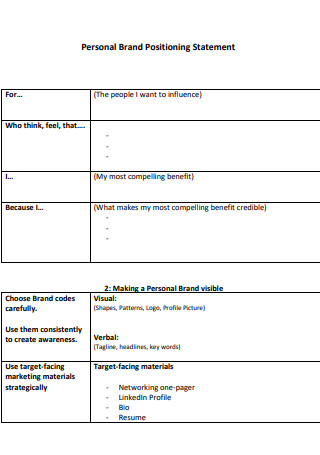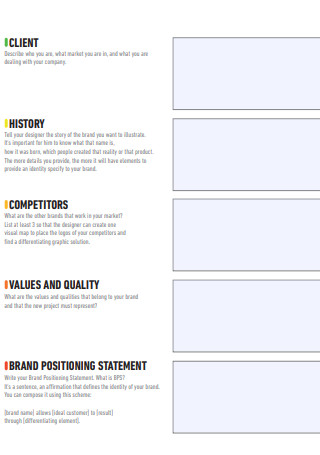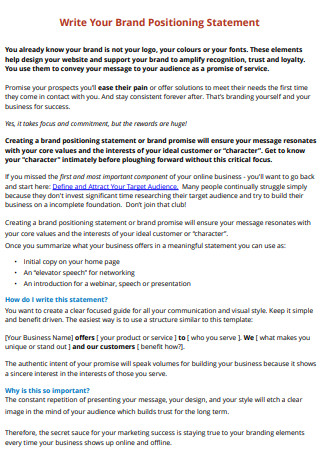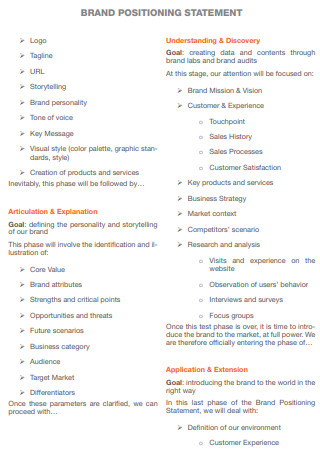5+ SAMPLE Brand Positioning Statement
FREE Brand Positioning Statement s to Download
5+ SAMPLE Brand Positioning Statement
What Is a Brand Positioning Statement?
Benefits of a Strong Brand
Tips to Correct Poor Brand Positioning
How to Write a Positioning Statement
FAQs
What is a positioning strategy?
Why is a positioning statement important?
What makes a brand successful?
What Is a Brand Positioning Statement?
A brand positioning statement describes precisely what your company does and for whom and differentiates it from competitors. The objective is to establish a distinct position for your brand in the senses of consumers within your category. While you may sell to a broad market and provide various benefits, ideally, your customers will recognize your one distinguishing core benefit, which the other benefits support. According to a survey, 46% of consumers in the United States are willing to pay more for products from trustworthy brands. The proportion of consumers who feel this way is comparable in other significant markets.
Benefits of a Strong Brand
A “brand” is, in its most basic form, the mental image that forms in a customer’s mind when they consider your business. Creating a visually appealing, memorable, and cohesive visual identity for your business is one primary way to shape this image positively. Suppose your company is fortunate enough to create a favorable impression in the minds of consumers. In that case, you will enjoy several advantages we will discuss in greater detail below. Consequently, what benefits do strong brands offer an organization?
Tips to Correct Poor Brand Positioning
There are many ways to evaluate and fix brand positioning, but none are helpful if you can’t devise a plan to fix the problems you find. As you go through each section, you’ll learn how to position your brand, make your business stand out, and use each point to improve your service. There are things you can do to correct lousy brand positioning. Here are some of them:
1. Retrieve Your Mission Statement
Sometimes it makes sense to return to the fundamentals. Your company was undoubtedly founded on a central concept or notion. You may have even created a mission statement in the early stages of your company. As a business expands and evolves, it can quickly lose sight of its original mission. If you determine that your organization requires a distinctive brand positioning, you may wish to revisit your mission statement. Your company’s mission statement can clarify your brand and help you remember the message you want to convey to customers. Don’t worry if you have never created a mission statement. Create one immediately and use it to evaluate your current communications. You can still complete this step if you choose not to make a mission statement. Each business operates with a central concept, so all that is required is reconnecting with it.
2. Think about your intended audience
After connecting with your mission statement and determining the best brand positioning to communicate it, you will need to consider your target market. Your communication must target its intended audience. Every business has an ideal customer. Your brand should communicate in a manner your target audience will comprehend and value. This step may involve reducing the amount of jargon that your general audience cannot understand. Instead, considering your audience may involve including information about your company and products that savvy buyers will find helpful and appreciate. Regardless of your steps, ensure that your brand is simple to comprehend, provides the audience with what it seeks, and accurately represents who you are.
3. Combat Poor Brand Positioning with Character
Incorporating your personality into your brand creates more opportunities for your audience to connect with you. Be careful not to obfuscate your message; otherwise, your brand positioning will continue to suffer. When you imbue your brand with a distinct personality, you can create the most advantageous brand positioning to differentiate yourself from the competition. People want to know what makes you unique, so give them a glimpse into your company’s culture.
4. Consider Language and Tone
Clarifying your language and tone is one of the most effective methods for avoiding poor brand positioning. In the section on target audiences, we discussed eliminating jargon; however, this also ties in perfectly with this step. Your core audience will appreciate language and tone that adhere to their expectations for a business while evoking personality. During this step, it is crucial to consider some communication guidelines that can be used in every interaction with your target audience.
5. Create credibility and reliance
Credibility and trust are two of the most crucial aspects of positioning a brand. Your audience will undoubtedly require evidence of your superior work. This increase in credibility will also inspire consumer confidence. A rise in credibility and trustworthiness can aid your company in avoiding poor brand positioning. This step may involve creating case studies, demonstrating thought leadership on social media, or collecting and distributing testimonials for your business.
6. Develop a Solid Brand Position through Consistency
Even if you spend countless hours developing your brand positioning, it will fail without consistency. Consistency allows you to remain at the forefront of a consumer’s mind, whereas other businesses may fade over time. This applies to how you communicate and the medium, frequency, and templates you employ.
How to Write a Positioning Statement
Positioning statements are internal tools that enable marketers to appeal effectively to their buyer personas. They are essential to any positioning strategy because they establish a distinct vision statement for the brand. A clear and brief positioning statement is important because it allows potential customers to understand your business at a glimpse. Customers want to know how your product and mission set them apart from the competition before they purchase your product. Consider the following guidelines when composing and assessing your positioning statement:
Step 1: Develop a vision board
Written documents are positioning statements. Since they lack images, video, and other visuals, it can be challenging to convey in a few sentences what your business is, who it serves, and why this is significant. Create a vision board to circumvent the initial “blank page” syndrome. Researchers discovered in a recent study that emotional response is linked to the visual elements of an image. To capitalize on this response, search for images that depict your customer in the environment where they have the greatest need for your product or service. Bringing your positioning statement to life can be aided by creating a vision board depicting your audience needing your product the most.
Step 2: Make it brief
The positioning statement for your brand should be concise and direct. If possible, aim for no more than three to five sentences. The more flowery your message, the less accurate it becomes. It then runs the risk of becoming more aspirational than your business is, with elements that are more exaggerated than based on reality.
Step 3: Make it unique and memorable
This statement should be specific to your organization and the problems you intend to solve. When crafting your positioning statement, emphasize your brand’s unique characteristics. Buyers should be able to recognize the exceptional value or problem that your business solves. Many markets are already saturated with products or services that are comparable to yours; therefore, your statement must be able to stand out against the background noise.
Step 4: Uphold the core principles of your company
The positioning statement is not the place to get creative and pitch a new business angle. The positioning statement for your brand should accurately reflect the company’s core values. Clear core values in your positioning statement communicate with your internal team. It assists new employees with alignment. In addition to letting consumers know your stances, it assists current team members in staying on track and delivering on your brand’s promises.
Step 5: Make your business stand out from the competition
An effective positioning statement should explain how a brand differs from its competitors. You can even consider a niche marketing strategy if you emphasize your company’s distinctive characteristics and how they benefit your customers. Are your brand’s campaigns related to a cause? Differentiate your brand by emphasizing your charitable objectives. Your brand serves a previously underserved audience, correct? Let them know clearly and confidently that you fill this void. There are ways to stand out from the group; you must survey your competitors to determine how you can do better things.
Step 6: Keep it simple
Your team should be able to align critical business decisions with your brand’s positioning statement in almost all situations due to its simplicity and readability. Your statement will be less convincing and engaging the more complex it is. Ensure that the value and offering of your business are crystal clear so that buyers will seek to learn more about it during their buyer journey.
FAQs
What is a positioning strategy?
A positioning strategy is a marketing strategy that focuses on differentiating a brand from its competitors. It is also known as a market or brand positioning strategy. A positioning strategy aims to influence consumer perception by effectively communicating a brand’s competitive advantage.
Why is a positioning statement important?
A positioning statement clarifies your competitors for you. Identifying opportunities and focusing on what makes your product or service superior to anything else on the market can be accomplished by placing your competition and describing how you differ from the various market participants.
What makes a brand successful?
Have a personality that is distinct and appropriate for your target audience. Be consistent in your messaging and design, reinforcing your brand’s position, promise, and character at every touchpoint. Demonstrate the customer value your company provides and how that value is created.
Ultimately, it is up to the client to decide who or what they prefer. And businesses are tasked with developing concepts that will leave a lasting impression on their brands. This will assist in positioning your products and services in the minds of your customers. With the correct brand positioning statement, your company can leave its mark on the market, despite the difficulty of the task and the intense competition.

